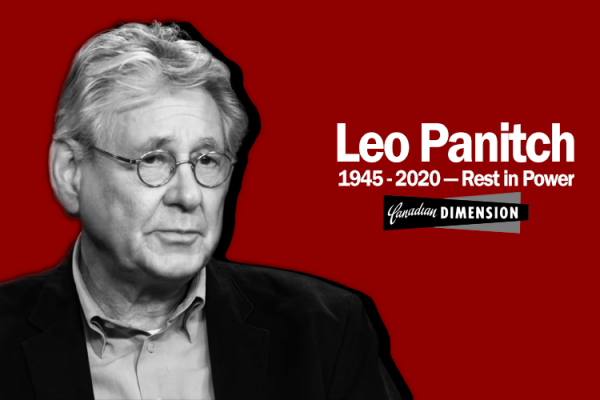The Fight Against Globalization Must Begin at Home
American pulp writer Don Westlake begins his recent novel, The Ax, with a now-common event: a lower-level manager in his late forties is laid off from a pulp mill and confronts the possibility that he may never again get a comparable job. Anxious about what he’ll be up against as he re-enters the labour market, he puts an ad in local papers for a fictitious job based on his own particular strengths. A pile of responses flows in, which he carefully narrows down to the six competitors he might face if a real job came up. He contemplates his situation:
“If I were to kill a thousand stockholders and get away with it clean, what would I gain? If I were to kill seven chief executives, each of whom had ordered the firing of at least two thousand good workers in healthy industries, what would I get out of it? Nothing. The CEOs and the stockholders who put them there are the enemy, but they are not the problem. They are society’s problem, but not my personal problem These six resumés. These are my personal problem.” Reluctantly, he concludes that to support his family adequately again, he must, literally, be ready to “kill for a job.” He must get rid of the senders of those six resumés.
As heavy-handed as the satire might be, it makes a powerful point: the barrier to popular resistance today is neither that people think the world is fine, nor that people are passive; rather, it is that, with no reason to believe that real change is on the agenda, people actively pursue other survival options. To maintain their consumption, health care and pensions, working-class families have increased their work hours; gone deeper in debt; refinanced their mortgages; supported tax cuts that favoured the rich in the hope of offsetting their own wage stagnation; and accepted more abuse at work. And when even that work was taken away, they have given up their community roots and wandered off to compete elsewhere for generally worse, but desperately needed, jobs.
The tragedy of this reaction extends beyond the obvious limits of its solutions. Worse still is the individualism and fragmentation such responses reinforce. If incomes are improved through longer hours, more debt, tax cuts and moving away–then class consciousness and class formation develop in radical different ways than if wage increases and social programs are won on picket lines, in the street, through mobilized communities. With class solidarity and ideological independence undermined by the form that personal coping takes, workers are condemned to face the same constrained options in the future as they do in the present.
The political dilemma is therefore not the fatalism of passively accepting your fate. It is rather the fatalism of acting within the given “structured options” instead of imagining, believing in and organizing to expand the possible options.
The Thirty “Glorious Years”
Through the late fifties and into the sixties, alongside the first post-war wave of globalization, the working class was able to win significant concessions from capital. But these gains proved to be temporary. Even though generally reformist, the militancy of workers proved to be more than capitalism could accommodate. Neoliberalism was the response. With neoliberalism, those same gains, which had earlier been identified as manifesting capitalism’s substantive democracy and its capacity to extend the good life, were now redefined as system-threatening barriers to the priority of capital accumulation.
A February, 1971 article in Time, addressing the disciplinary significance of the 1971 recession, candidly expressed the logic behind the more comprehensive neoliberal reaction that was to come:
“Adversity has its uses: the recession has played a calming role in America. Looking for a job takes precedence over looking for trouble. Sidewalks are too narrow for [both] protest marchers and food stamp lines.”
It might have been expected that capitalism’s aggressive turn to the priorities of business at the expense of broader needs would in time lead to some sort of crisis in capitalism’s legitimacy. Instead, our inability to develop a counter-response led to the actual crisis emerging on the Left, rather than the Right. And that crisis–occasional glimmers of hope aside–continues virtually everywhere today.
How are we to understand this impasse? Can it be escaped? What are the dimensions–the sites of struggle, principles of justice, strategic orientations and social agency–of the long march to getting radical change on the agenda? More specifically, how has globalization affected the nation state as the primary site of political activity? What is the relationship between nation-based struggles and the universalist aspect of social justice? How might we counteract the authoritative weight carried by “competitiveness”? Is Marx’s identification of the working class as the revolutionary agency still credible? And, if so, can the decline of unions–the principal organizational site of workers–be reversed and, more ambitiously, renewed, in order that they may contribute to a larger transformative project?
Globalization Has Not Rendered the Nation State Irrevelant
All sites of resistance matter. Nevertheless, the political issue is not just how to prioritize which sites are the most important at a particular time, but also how to conceive of the relationship between the various sites. In our era, the deepening of globalization seems to have subordinated the salience of the national to the dominance of the international. Yet, as early as 1848, in the context of a keen awareness of capitalism’s tendency to globalization, Marx and Engels presciently asserted in the Communist Manifesto that “Though not in substance, yet in form, the struggle with the bourgeoisie is at first a national struggle. The proletariat of each country must, of course, first of all settle matters with its own bourgeoisie.” Accumulation may increasingly be international in scope, but the social foundation of its power–property rights, contracts, the credibility of currencies, labour rights and labour markets–are established and reproduced at the level of nation states.
When General Motors expands into Europe, Latin America and China, it is not escaping a dependence on the American state but rather becoming dependent on more states as well as increasing its dependence on the international role of the American state. When we speak of the “internationalization of states,” the issue is not a decrease in the role of states but their taking on–sometimes enthusiastically, sometimes reluctantly–the additional responsibility, within their own borders, for supporting international accumulation. When the IMF, World Bank and WTO are targeted as the face of globalization, they serve–in spite of a necessary degree of autonomy–at the behest of nation states rather than as their proto-state replacements.
The fact that social power is rooted nationally suggests the need to direct opposition to that same level. However, more is at stake than simply following where power goes. Resistance cannot be separated from place; concrete and sustained mobilization can only occur within historical communities that must be built nationally before they can aspire to an effective internationalism.
However, to emphasize the centrality of nation states does not mean a return to the notion of identifying social transformation with seizing the state. The states in question are capitalist states not only by virtue of who happens to be at the helm at any moment, but by virtue of their historical development. The particular structures capitalist states embody include hierarchical decision-making appropriate to managing a capitalist economy, but not to the democratic administration of social life. Transforming such states so that the process of democratization can be extended into the economy and everyday life, and so that the state is democratic in the deepest sense of mobilizing and developing popular capacities for self-management, involves struggles inside the state that are simultaneously and aggressively pushed by movements outside the state, and which are ultimately protected from isolation by parallel struggles and movements in other states.
The National and the Universal
Until unions and the new social movements develop effective bases nationally, the concrete support they can offer others is limited. They can and must do international solidarity work. Nevertheless, any substantive transfer of technology, any significant shift in resources, any mutually beneficial restructuring of trading relationships, any reconstitution of international bodies, requires having the resources and institutional backing of state power.
This is perhaps most obvious in the case of the American state. The greatest international contribution the American Left can make involves coming to grips with their own state. But this strategic emphasis on the national is also true within the Third World. For all the impressive contributions the anti-globalization movement has made to a consciousness of international injustices and the need for international solidarity, Third World development does not depend so much on what we can do for them. Rather, it is by acting within our own countries that we can help expand the space available for the peoples of the Third World to come to grips with their own states and ruling classes. As we develop the capacity to struggle more effectively within our own countries, the safe and flexible havens available to corporations become more limited and we help to open the space for struggles elsewhere. In this sense, national struggles are internationalized.
There is an additional, too often neglected way in which national struggles must be internationalized. Reflecting a desperation for models to inspire it, the Left tends to look to particular developments abroad in order to emulate them or judge them. But these are struggles-in-process, feeling their way through new terrains–struggles we must not only support, but especially learn from. There has not been enough of the kind of critical but comradely exchange with those directly involved about the lessons–bad as well as good–emerging from what are not so much models, as historic experiments, in social change.
Escaping the Terrain of Competitiveness
As long as we remain on the terrain of competitiveness, no effective challenge to capitalism is possible. Whatever “progressive” face Third Way-ists try to place on it–as with “training” or “industrial strategies”–the goal of competitiveness is, to begin with, morally indefensible: its underlying principle is that access to employment for one group of workers essentially comes from undermining the standards–and taking the jobs–of others. At best, it promises permanent insecurity, since even “winning” is an inherently temporary and fragile circumstance. And competitiveness is ultimately destructive to building any kind of independent political capacity, because the alliances it invites are with “our employers,” while the enemy it identifies is other workers.
Competitiveness is, of course, more than an ideological construct; it is a real-word constraint. But there is a world of difference between acknowledging a constraint that we must deal with in the short run, as opposed to raising it to the status of a goal by talking about the oxymoron of “progressive competitiveness.” The issue is how to cope with this constraint as we move to limit and eventually eradicate its dominance over our lives.
It is important to emphasize that to reject competitiveness is not to reject being “productive.” On the terrain of competitiveness, the removal of tools and equipment from a community may be rational; on the terrain of democratic capacities, it robs workers of their productive potentials. Competitiveness directs training towards teaching workers to adapt to technology; the focus on democratic capacities instead raises the issue of how to control technology. Competitiveness hoards knowledge; a focus on collective capacities looks to generalize and therefore democratize knowledge.
Any practical challenge to competitiveness necessarily implies challenging the freedom of capital to restructure production across firms, sectors and borders. The issue of limiting capital’s freedom to ignore borders inherently involves a degree of “protectionism,” risking a corresponding national chauvinism. As Greg Albo has insisted in the Socialist Register 1997, it is therefore crucial to understand this response in the context of the attempt to create and protect national spaces for democratic experimentation with other ways to organize our lives. What we are “protecting” ourselves against is not other societies–whose popular forces also need to develop such spaces–but capital’s unilateral right to decide the allocation of resources, goods, investment and labour. What we are rejecting is not integration into an international economy, but a particular kind of integration: one that dominates, and thereby undermines, what we (again the international “we”) are struggling to build within each of our domestic spaces.
What Agency? What Transformation?
Mike Lebowitz (Beyond Capital) has rigorously argued that, although workers clearly fight for gains within capitalism, there is no convincing case that the working class will spontaneously organize itself to go “beyond capitalism.” Why would a working class that is fragmented across competitive workplaces and individualized communities; divided amongst diverse identities; dependent upon capital for its daily survival; and whose capacities and hopes are regularly stunted by capitalism–why would we expect such a working class to rise up suddenly (or even think of rising up) against the system as a whole?
Yet, if we consequently decide to say “farewell to the working class” (Andre Gorz) as a radical agency, then we should be aware of the implications: without the working class, radical change simply won’t happen. Though the catalyst for transformative change may come from elsewhere, other movements cannot sustain themselves without the financial and organizational resources of unions’ and workers’ strategic location in production and services. The movement can demonstrate; workers can shut down the economy. A decade later, even Gorz acknowledged as much when he conceded that, “as the best organized force in the broader movement,” it was upon the unions that “the success or failure of all the other elements in this social movement [would depend].”
The crucial point is that social transformation is not inevitable, but contingent upon what happens inside a working class that is neither inherently revolutionary, nor frozen in time. What distinguishes the working class under capitalism is that it contains the possibility–and only the possibility–of changing itself as part of, and as an essential condition for, changing society.
An immediate challenge to those larger possibilities is whether workers can revive their unions. For, if workers can’t even transform their unions, how can they possibly transform society? The context is that, while capitalism has dramatically changed over the past quarter century, unions have not. While capital aggressively pursued its neoliberal option after the “golden age,” unions looked for a return to a no-longer-possible middle ground and remain unprepared–sporadic struggles aside–to lead any fundamental challenge to the trajectory of the status quo.
A Larger Vision
The revival of unions will consequently require what amounts to a revolution inside unions. The issue is not simply trying harder, raising targets for monies going into organization, making a greater commitment to democratic practices, or looking to more effective political involvement. These are all admirable, but, given what unions today now confront, even the modest goal of union revival–let alone the development of its capacities for social transformation–appears increasingly unrealistic without some larger vision.
Unless unions see organizing as part of building the working class–and not only as gaining members for themselves–the kind of energy and commitment needed to generate an explosion of unionization will not emerge. Unless unions see the extension of membership involvement in union affairs as part of developing and generalizing new capacities, including discovering new ways to collectively address common problems, commitments to internal democracy will remain more formal than substantive. Unless unions are ready to act on a view of their members as more than “just workers,” but as full human beings whose needs and potentials are blocked by capitalism, politics will continue to bounce between hoping the next national leader won’t be as bad as the present one and the sterility of lobbying without a mobilized power base.
Getting the Ax Again
To return to American pulp writer Donald Westlake, the “problem” for those looking to radical change is not the competitive resumés of other workers, the bad corporate apples in barrels full of poison, nor a disembodied, stateless globalization. The problem is a capitalist system no longer strong enough to fulfill and generalize promises of human development, but still strong enough to reproduce itself in spite of that failure. And capitalism will retain that strength as long as its opposition, most importantly the labour movement, poses no fundamental barriers to capital’s prerogatives. Creating such an opposition means thinking and organizing on the grand scales that the idea of “socialism” once represented. The revival of the labour movement now depends upon the revival of socialist ideas and a socialist movement that exists both inside and outside the unions.
Can a new generation of activists and workers convert the failures of neoliberalism in human terms and the ugliness of the now-unconcealed American empire, into the building blocks of such a movement? Can such a movement convert the argument that “there is no alternative,” into “there is no alternative but to start moving beyond capitalism?”
Sam Gindin is a member of CDʼs Editorial Collective.
This article appeared in the November/December 2004 issue of Canadian Dimension .










